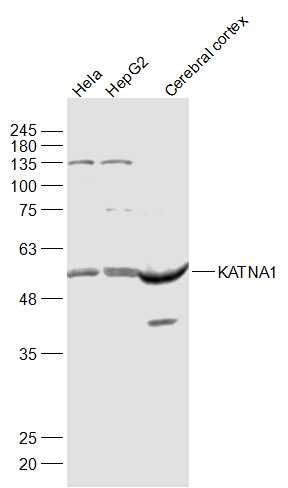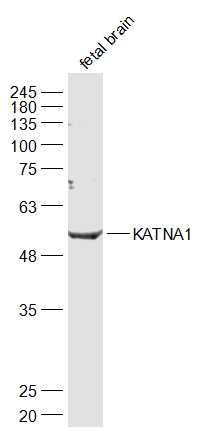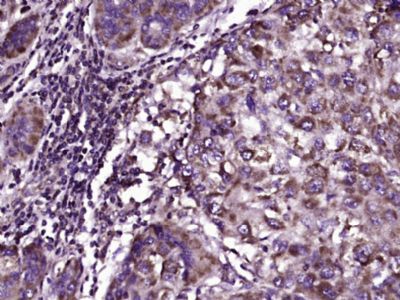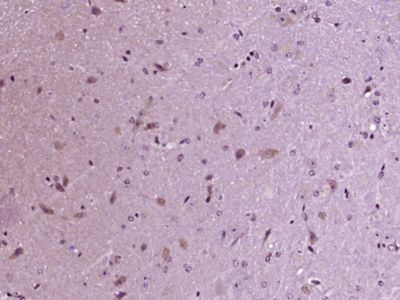KATNA1 Polyclonal Antibody
Purified Rabbit Polyclonal Antibody (Pab)
- 产品详情
- 实验流程
Application
| WB, IHC-P, IHC-F, IF, E |
|---|---|
| Primary Accession | O75449 |
| Reactivity | Rat, Pig, Dog, Bovine |
| Host | Rabbit |
| Clonality | Polyclonal |
| Calculated MW | 55965 Da |
| Physical State | Liquid |
| Immunogen | KLH conjugated synthetic peptide derived from human KATNA1/Katanin p60 A1 |
| Epitope Specificity | 221-320/491 |
| Isotype | IgG |
| Purity | affinity purified by Protein A |
| Buffer | 0.01M TBS (pH7.4) with 1% BSA, 0.02% Proclin300 and 50% Glycerol. |
| SUBCELLULAR LOCATION | Cytoplasm. Cytoplasm, cytoskeleton, centrosome. Cytoplasm, cytoskeleton, spindle pole. Cytoplasm, cytoskeleton. Note=Predominantly cytoplasmic. Also localized to the interphase centrosome and the mitotic spindle poles. Enhanced recruitment to the mitotic spindle poles requires microtubules and interaction with KATNB1. |
| SIMILARITY | Belongs to the AAA ATPase family. Katanin p60 subunit A1 subfamily. |
| SUBUNIT | Can homooligomerize into hexameric rings, which may be promoted by interaction with microtubules. Interacts with KATNB1, which may serve as a targeting subunit. Interacts with dynein and NDEL1. Associates with the E3 ligase complex containing DYRK2, EDD/UBR5, DDB1 and VPRBP proteins (EDVP complex). |
| Post-translational modifications | Ubiquitinated by the EDVP E3 ligase complex and subsequently targeted to proteasomal degradation. |
| Important Note | This product as supplied is intended for research use only, not for use in human, therapeutic or diagnostic applications. |
| Background Descriptions | Microtubules are polymers of alpha and beta subunits that form the mitotic spindle and assist in the organization of membranous organelles during interphase. Katanin p60 A1, also known as KATNA1, is a 491 amino acid protein that belongs to the AAA ATPase family and is involved in microtubule regulation. Localized to the cytoplasm and to the centrosome, Katanin p60 A1 functions to sever and disassemble microtubules in an ATP-dependent manner, thus promoting the rapid reorganization of cellular microtubule arrays and playing an important role in microtubule release from the centrosome after nucleation. Katanin p60 A1, which exists as two alternatively spliced isoforms, can homooligomerize into hexameric rings whose activity is stimulated by the presence of microtubules. |
| Gene ID | 11104 |
|---|---|
| Other Names | Katanin p60 ATPase-containing subunit A1 {ECO:0000255|HAMAP-Rule:MF_03023}, Katanin p60 subunit A1 {ECO:0000255|HAMAP-Rule:MF_03023}, 5.6.1.1 {ECO:0000255|HAMAP-Rule:MF_03023}, p60 katanin {ECO:0000255|HAMAP-Rule:MF_03023}, KATNA1 {ECO:0000255|HAMAP-Rule:MF_03023} |
| Dilution | WB=1:500-2000,IHC-P=1:100-500,IHC-F=1:100-500,IF=1:50-200,ELISA=1:5000-10000 |
| Format | 0.01M TBS(pH7.4) with 1% BSA, 0.09% (W/V) sodium azide and 50% Glyce |
| Storage | Store at -20 °C for one year. Avoid repeated freeze/thaw cycles. When reconstituted in sterile pH 7.4 0.01M PBS or diluent of antibody the antibody is stable for at least two weeks at 2-4 °C. |
| Name | KATNA1 {ECO:0000255|HAMAP-Rule:MF_03023} |
|---|---|
| Function | Catalytic subunit of a complex which severs microtubules in an ATP-dependent manner. Microtubule severing may promote rapid reorganization of cellular microtubule arrays and the release of microtubules from the centrosome following nucleation. Microtubule release from the mitotic spindle poles may allow depolymerization of the microtubule end proximal to the spindle pole, leading to poleward microtubule flux and poleward motion of chromosome. Microtubule release within the cell body of neurons may be required for their transport into neuronal processes by microtubule-dependent motor proteins. This transport is required for axonal growth. |
| Cellular Location | Cytoplasm. Midbody. Cytoplasm, cytoskeleton, microtubule organizing center, centrosome {ECO:0000255|HAMAP-Rule:MF_03023} Cytoplasm, cytoskeleton, spindle pole. Cytoplasm, cytoskeleton, spindle. Note=Predominantly cytoplasmic (PubMed:9658175). Localized diffusely in the cytoplasm during the interphase (PubMed:10751153). During metaphase is localized throughout the cell and more widely dispersed than the microtubules. In anaphase and telophase is localized at the midbody region (PubMed:19261606). Also localized to the interphase centrosome and the mitotic spindle poles (By similarity). Enhanced recruitment to the mitotic spindle poles requires microtubules and interaction with KATNB1 (PubMed:10751153). Localizes within the cytoplasm, partially overlapping with microtubules, in interphase and to the mitotic spindle and spindle poles during mitosis (PubMed:26929214). {ECO:0000255|HAMAP- Rule:MF_03023, ECO:0000269|PubMed:10751153, ECO:0000269|PubMed:19261606, ECO:0000269|PubMed:26929214, ECO:0000269|PubMed:9658175} |
Research Areas
For Research Use Only. Not For Use In Diagnostic Procedures.
Application Protocols
Provided below are standard protocols that you may find useful for product applications.
终于等到您。ABCEPTA(百远生物)抗体产品。
点击下方“我要评价 ”按钮提交您的反馈信息,您的反馈和评价是我们最宝贵的财富之一,
我们将在1-3个工作日内处理您的反馈信息。
如有疑问,联系:0512-88856768 tech-china@abcepta.com.
¥ 1,500.00
Cat# AP59215























 癌症的基本特征包括细胞增殖、血管生成、迁移、凋亡逃避机制和细胞永生等。找到癌症发生过程中这些通路的关键标记物和对应的抗体用于检测至关重要。
癌症的基本特征包括细胞增殖、血管生成、迁移、凋亡逃避机制和细胞永生等。找到癌症发生过程中这些通路的关键标记物和对应的抗体用于检测至关重要。 为您推荐一个泛素化位点预测神器——泛素化分析工具,可以为您的蛋白的泛素化位点作出预测和评分。
为您推荐一个泛素化位点预测神器——泛素化分析工具,可以为您的蛋白的泛素化位点作出预测和评分。 细胞自噬受体图形绘图工具为你的蛋白的细胞受体结合位点作出预测和评分,识别结合到自噬通路中的蛋白是非常重要的,便于让我们理解自噬在正常生理、病理过程中的作用,如发育、细胞分化、神经退化性疾病、压力条件下、感染和癌症。
细胞自噬受体图形绘图工具为你的蛋白的细胞受体结合位点作出预测和评分,识别结合到自噬通路中的蛋白是非常重要的,便于让我们理解自噬在正常生理、病理过程中的作用,如发育、细胞分化、神经退化性疾病、压力条件下、感染和癌症。









